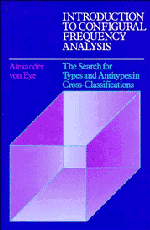 Introduction to Configural Frequency Analysis
Introduction to Configural Frequency Analysis Book contents
- Frontmatter
- Contents
- Preface
- Part I Concepts of configural frequency analysis
- 1 The analysis of contingency tables
- 2 Testing for types and antitypes
- 3 Models of CFA: concepts and assumptions
- Part II Applications and strategies of CFA
- Part III Methods of longitudinal CFA
- Part IV Strategies of CFA and computational issues
- Appendix A Computational issues. The estimation of tail probabilities for the standard normal and the F distributions
- Appendix B Estimation of expected frequencies in 2 × 2 × 2 tables under the assumption that main effects and first order interactions exist
- Appendix C Critical alpha levels under Holm adjustment for up to 330 cells and a priori alphas 0.05 and 0.01
- References
- Subject index
- Author index
3 - Models of CFA: concepts and assumptions
from Part I - Concepts of configural frequency analysis
Published online by Cambridge University Press: 04 August 2010
- Frontmatter
- Contents
- Preface
- Part I Concepts of configural frequency analysis
- 1 The analysis of contingency tables
- 2 Testing for types and antitypes
- 3 Models of CFA: concepts and assumptions
- Part II Applications and strategies of CFA
- Part III Methods of longitudinal CFA
- Part IV Strategies of CFA and computational issues
- Appendix A Computational issues. The estimation of tail probabilities for the standard normal and the F distributions
- Appendix B Estimation of expected frequencies in 2 × 2 × 2 tables under the assumption that main effects and first order interactions exist
- Appendix C Critical alpha levels under Holm adjustment for up to 330 cells and a priori alphas 0.05 and 0.01
- References
- Subject index
- Author index
Summary
This section gives a brief overview of CFA models. A CFA model is characterized by the assumptions the researcher makes when estimating expected frequencies. The second part of this book describes each model in more detail and gives numerical examples.
CFA performs multiple simultaneous or sequential tests to compare observed frequencies, o, with expected ones, e, estimated under some model. Significant differences between o and e indicate local associations beyond the ones assumed when estimating expected frequencies. For the estimation of expected frequencies methods from log-linear modeling can be used (see Bishop et al. 1975; Goodman 1978; Haberman 1978; Agresti 1984). However, the goals of CFA and log-linear modeling are basically different (cf. Krauth 1980a; Lehmacher 1980a, 1984). When applying CFA, the researcher wants to reject null hypotheses concerning single configurations. If null hypotheses can be rejected, types and antitypes may be interpreted. The focus of this interpretation is on the subjects who display patterns of states, or configurations that occurred more or less frequently than expected under some model.
When applying log-linear modeling, the researcher intends to identify the null hypothesis that provides the best fit to the observed frequency distribution. In other words, the researcher attempts to identify a set of relationships that explains the observed frequency distribution. When evaluating fit one refers to such statistical criteria as significance thresholds and to such philosophical criteria as parsimony.
- Type
- Chapter
- Information
- Introduction to Configural Frequency AnalysisThe Search for Types and Antitypes in Cross-Classification, pp. 46 - 58Publisher: Cambridge University PressPrint publication year: 1990
